Oberlin Alumni Magazine
Spring 2007 Vol. 102 No. 3
Around Tappan Square
Art of the Idea: Sol Lewitt's legacy lives on at Oberlin
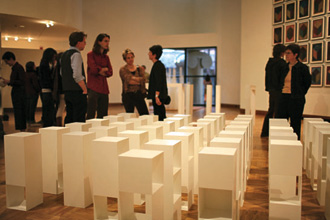

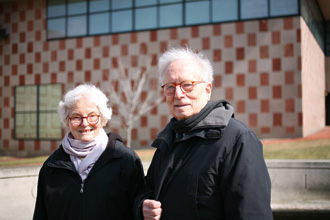 This year marks the 30th anniversary of the completion of the AMAM's Ellen Johnson Gallery and the Art Building additiion, designed by architects Robert Venture and Denise Scott Brown. On view through June 30 is Between "Plain and Fancy": Venture at Oberlin, which includes drawings by Venturi and Cass Gilbert, architect of the original 1917 building.
This year marks the 30th anniversary of the completion of the AMAM's Ellen Johnson Gallery and the Art Building additiion, designed by architects Robert Venture and Denise Scott Brown. On view through June 30 is Between "Plain and Fancy": Venture at Oberlin, which includes drawings by Venturi and Cass Gilbert, architect of the original 1917 building.
After a hiatus of nearly a decade, a work by pioneer conceptual artist Sol LeWitt, 49 Three-Part Variations on Three Different Kinds of Cubes, again stands in full glory at the Allen Memorial Art Museum.
The white, enamel-on-steel work, which was purchased by the museum in 1972, underwent extensive restoration recently in preparation for an exhibition of Sol LeWitt’s work at the AMAM. Its installation was timed to coincide with the 30th anniversary of the Ellen Johnson Gallery and the Art Building addition. The architects of those structures, Robert Venturi and Denise Scott Brown, returned to Oberlin on March 10 to celebrate the occasion.
In a sad turn of events, LeWitt, who in the 1970s and 1980s helped establish Conceptualism and Minimalism as important art movements, died on April 8.
The exhibition, which runs through July 22, features LeWitt works from the museum’s own collection, 24 works from the artist’s personal collection, and two new wall drawings—each measuring more than 18 feet high—created by LeWitt specifically for the Ellen Johnson Gallery.
49 Cubes, which represents the artist in his prime, explores three types of cubes: solid cube, cube with opposite sides removed, and cube with one side removed. The piece underscores LeWitt’s belief that concept is the most important aspect of a work of art. As LeWitt famously said, “The idea is that the machine makes the art.”
This idea—that machine and art can be intertwined—finds continued expression in a colorful wall drawing that looms over LeWitt’s stark cubes. Rainbow stripes with straight, razor sharp edges unmarred by paint drips blindingly shadow a prominent black X. “Working on the painting, I was impressed by how much intensive human effort is required to make the work look technically perfect, as though machine-made,” says Julia Feldman ’08, who worked on Primary and secondary colors with black X.
On a wall opposite is a massive graphite drawing (23 feet high by 18 feet wide) with dark gray bands that stretch seamlessly across the wall. The piece has an incredible evenness and calmness, a soft quality probably due to the use of graphite pencil.
Each of the large wall pieces was executed by assistants—Oberlin students and museum staff members—overseen by representatives from LeWitt’s New York studio.
“The entire collaboration with Sol LeWitt and his curator to restore the Allen’s sculpture was an exciting moment for the campus, culminating in LeWitt’s gift of a major wall drawing to Oberlin,” says Stephanie Wiles, the John G.W. Cowles Director of the Allen.
The exhibit as a whole draws on various points of LeWitt’s life, from art student in New York to a leader of Minimalism and Conceptual art. “It’s a meaty, satisfying show on many levels,” wrote art critic Dorothy Shinn in the Akron Beacon Journal. “The show, perhaps the last to have been personally conceived by LeWitt, is certainly worth a trip to Oberlin to see.”
From Sports to the Stage, Anxiety Affects Success
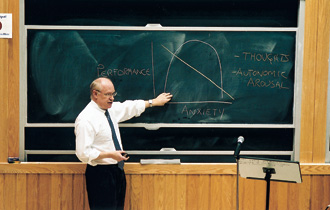
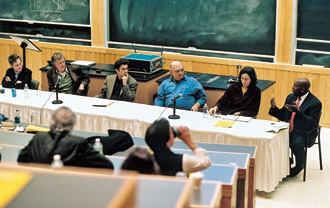 Got nerves? A panel of alumni, faculty members, and coaches discussed the topic of performance anxiety at a symposium sponsored by the Heisman Club in March.
Got nerves? A panel of alumni, faculty members, and coaches discussed the topic of performance anxiety at a symposium sponsored by the Heisman Club in March.
After 17 years as a television reporter, ESPN correspondent George Smith is all too familiar with the performance anxiety that comes from talking to millions of viewers. “Live work is a big part of what I do,” said Smith ’87. “The mistakes can be humiliating, but you develop coping mechanisms.”
Visiting Assistant Professor of Opera Theater Sally Stunkel said the anxiety she experiences as a singer-performer makes her a more effective teacher and director.
And as for orthopedic surgeon Paul Treuhaft ’64, feelings of anxiety are simply part of the job: “Being a surgeon is all about performing under pressure—always.”
These and other insights into performance anxiety were offered during an all-campus symposium in March sponsored by the Heisman Club. Titled “Caught In the Spotlight: Anxiety and Performance,” the event marked a commitment by the Club to reach beyond athletics by supporting student health and wellness campuswide.
“In my mind, the quest for excellence, either on the athletic field, the stage, in the art museum, or in an orchestra, is a huge shared and unifying experience for students,” said Heisman Club President-Elect Carla Freyvogel ’79.
Dennison Smith, Norman D. Henderson Professor of Neuroscience, said that by knowing how our brains operate we can overcome the negative impact of anxiety. “Performance anxiety originates from a fear that one may underperform in view of actual or implied expectations.”
Ways of dealing with performance anxiety, he said, while simple to grasp, are often difficult to practice: setting realistic goals, building self-confidence, finding ways to relax, exercising, talking positively to yourself, controlling distractions, and imagining peak performance.
Matthew Wright, associate professor of theater and dance, gave an example of playing the lead in Around the World in 80 Days, in which he forgot his lines. “I handled it by turning my back to the audience and signaling for the cast to carry on. That experience taught me that I wasn’t perfect, and didn’t need to be,” he said.
Women’s Head Basketball Coach Christa Champion said the differences between success and mediocrity often come down to a person’s “ability to bounce back from failure.” It also has a great deal to do with preparation—both physical and mental.
“I truly believe that greatness is a choice,” added Ray Appenheimer, head of the men’s and women’s cross country teams and assistant track coach. As a five-time NCAA All-American runner, he recalled races that made him so nervous that he couldn’t tie his own shoes. That’s when he’d remind himself of past accomplishments. Those real-life mental images, coupled with his intense physical preparation, calmed his anxiety and allowed him to perform.
The daylong symposium ended with visiting theater and dance instructor Deborah Vogel leading participants through physical and mental exercises designed to redirect stress.
“The symposium was an effective way to connect many types of performance through common experience of anxiety,” concluded Roger Laushman, originator of the event. “Credit to Carla for bringing all of the pieces together.”
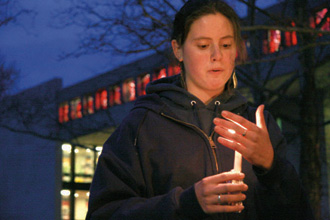 Standing and Remembering: An Oberlin student participates in a candlelight vigil held for the students and staff killed at Virginia Polytechnic Institute April 16. Students also painted, signed, and circulated a large banner that was sent to the school and constructed a memorial outside of Wilder Hall.
Standing and Remembering: An Oberlin student participates in a candlelight vigil held for the students and staff killed at Virginia Polytechnic Institute April 16. Students also painted, signed, and circulated a large banner that was sent to the school and constructed a memorial outside of Wilder Hall.
Arabic Classes Burst at the Seams
Forget the typical student stunt of trying to stuff a dozen bodies into a phone booth; at Oberlin in February, it was a classroom that students were cramming—all in an effort to snag a seat in Oberlin’s new course in beginning Arabic.
“There were people in the hallways, all over the floor, people sticking their heads inside, trying to get as many bodies in as possible. Clearly, the interest is there,” says Fadil Bayyari ’07, who tutors students in Arabic.
Those who couldn’t find a seat resorted to signing a petition asking for an added section of Arabic 101. College administrators honored the request, and acceptance from an extensive waitlist was arranged by lottery. Approximately 50 students enrolled in three Arabic courses: two beginning and one intermediate. Classes were taught this semester by Visiting Professor Marie-Claude Thomas.
“There is no way that Oberlin would be able to compete with other colleges [in the languages] if we didn’t offer Arabic,” says Assistant Professor of French Ali Yedes, who in the past has taught Arabic to select students in private readings. “Oberlin has always been at the forefront of activity that concerns humans in general. This affects not just America or Oberlin, but the whole world. We should be out there.”
Many of Oberlin’s peer colleges are beginning to offer courses in Arabic; others, such as Mount Holyoke, have had a program for years. A student referendum question last spring revealed that more than half of Oberlin’s student body would support the creation of an Arabic language program.
The beginning of such a program would also mark a step toward strengthening course offerings in Middle Eastern and North African studies, which in recent years has included coverage of the region’s religion, art, literature, and politics.
While Thomas was hired for just one semester, the College has agreed to fund a teaching position in the course for the next two years, during which time it will be evaluated to determine its continuation, says Nick Jones, associate dean of the College of Arts and Sciences. Yedes is hopeful.
“I’m sure it will not stop,” he says. “[Stu-dents] are not going to be satisfied with studying Arabic for just one or two years. They will want to continue and be sent to Egypt, to Jordan, to Tunisia, to all kinds of programs.”
“For Arabs and for the Middle East, speaking Arabic is what defines being Pan-Arabic. It’s not what skin color you are, or what country you’re from,” says Bayyari. “Everybody speaks this language, from North Africa to the Middle East to the Arabian Peninsula. One of the biggest things we lack in this country is an understanding of the history of these regions. It’s much different today than it was thousands of years ago. Understanding these differences will build bridges and borders linking the West to the Middle East.”
Mary Page Terlizzi ’10, who is considering a major in international politics, agrees. “I would want to focus on the Middle East, and if I were to get involved with politics in that region, I would need to communicate. You have to know the culture and the language if that’s going to be your life.”
Recognizing a Pioneer
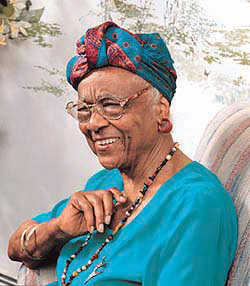
Marjorie Witt Johnson’s life and work as a pioneering dance educator was celebrated during Black History Month with the staging of the biographical dance drama Daughter of a Buffalo Soldier. Co-created, directed, and choreographed by Dianne McIntyre and Michael Medcalf, the piece was performed in Warner Main Space by dancers and actors from the Cleveland Contemporary Dance Theatre and six Oberlin students.
Daughter of a Buffalo Soldier had its world premier at Cleveland’s Karamu House theater in 2005, where Johnson ’35 had joined founders Russell and Rowena Woodham-Jelliff ’14 after her own graduation. There she helped introduce modern dance to black youth. Known as the Karamu Dancers, the Cleveland troupe eventually made its way to the 1940 World’s Fair in New York.
“From the company Marjorie formed, so many other people became interested in modern dance, and many of them became teachers,” says McIntyre, who worked extensively with Johnson during the creation of Buffalo Soldier. “Even into her 80s she was teaching and bringing dance into schools. Although not everyone who studied with her become a dancer, their self-esteem was greatly improved.”
The Oberlin students who performed in the play rehearsed at Karamu House. McIntyre also performed a winter-term residency on campus; 17 students created dance numbers for Front Porch Lies, based on five folktales by Zora Neale Hurston. It also premiered at Oberlin.
Although a recent stroke prevented Johnson, 97, from viewing the Oberlin performance, her daughter, Corrine Falope, was in attendance.
When Voting Rights Go Wrong
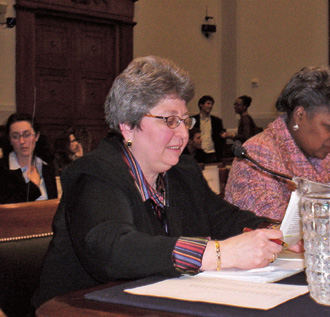
“Sadly, I report that to someone like me in a small town in Ohio, it appears that every aspect of the [Ohio 2006 and 2004 presidential] election process was undermined by a Republican Secretary of State’s office,” Associate Professor of Politics Eve Sandberg told members of the U.S. House of Representatives’ Committee on the Judiciary in March.
Sandberg was one of nine speakers, including Illinois senator and presidential candidate Barak Obama, to present testimony at a March 7 hearing, “Protecting the Right to Vote: Election Deception and Irregularities in Recent Federal Elections.”
Points in Sandberg’s testimony included the lack of voting machines in largely Democratic precincts—which resulted in many voters having to stand in long lines for hours—and unlawful challenges of a citizen’s right to vote. She also outlined problems with voter registration in 2004, particularly with regards to out-of-state Oberlin students who wished to vote in Ohio.
“I hope that the United States Congress, after hearing our testimony today, will restore our faith in our political leadership and work to restore free and fair election practices in Ohio and elsewhere throughout our country,” Sandberg concluded.
Obies on hand at the hearing included Matthew Kaplan ’05, legislative aide to U.S. Rep. Marcy Kaptur of Ohio; Dena Iverson ’05, speechwriter and deputy communications director for D.C. Mayor Adrian Fenty ’92; Desiree Pipkins ’06, research director at the NAACP Legal Defense and Education Fund; Joel Heller ’06, congressional intern for Senator Sherrod Brown of Ohio; and Ary Amerikaner ’05, legislative aide to U.S. Rep. Mazie Hirono of Hawaii.
Read Sandberg’s testimony at: http://judiciary.house.gov/oversight.aspx?ID=279
Understanding China
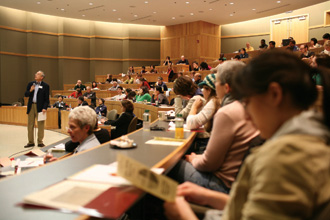 An expert on the economics of China, Ralph Huenemann ’61 spoke at Oberlin’s “China Rising” symposium. He is a visiting professor of economics and business at Peking University in Beijing.
An expert on the economics of China, Ralph Huenemann ’61 spoke at Oberlin’s “China Rising” symposium. He is a visiting professor of economics and business at Peking University in Beijing.
To cultivate a deeper understanding of contemporary China and its rapid rise in world power, the East Asian Studies Program invited five alumni speakers to its March symposium, “China Rising,” organized by Associate Professor Qiusha Ma.
Sophie Richardson ’92, deputy Asia director at Human Rights Watch, opened the program by addressing several human rights actions China might take, including ratifying the International Covenant on Civil and Political Rights, allowing nongovernmental organizations to freely register, and reversing its practice of censoring the Internet and the media.
“But old habits die hard. The money spent by the Chinese government to monitor Internet activity is almost as much as its national health budget,” she said.
Social activism in China is increasing, particularly protests over environmental issues and local corruption, said Thomas Gold ’70, associate dean of international and area studies and associate professor of sociology at U.C. Berkeley.
“In 2005, 87,000 protests were reported by the Ministry of Public Security, up from 58,000 in 2003,” he said. “Such activism encourages the Communist government to add policies and programs to “clean up and protect the environment and to sustain green economic growth.”
But growth-driven local officials don’t always follow such policies, presenting a challenge to foreign-owned businesses competing with Chinese counterparts, said Timothy Liang ’71, senior vice president of JSJ Corporation and managing director of JSJ China.
Nonetheless, the rate of foreign invest-ment in the technology-driven country remains strong, as evidenced by the growing presence of wholly owned foreign enterprises and joint ventures, said Ralph Huenemann ’61, visiting professor of economics and international business at the Guanghua School of Management at Peking University.
The greatest economic concern for the U.S. is the trade gap, he said. The booming Chinese economy accounts for about 30 percent of the U.S.’s $725.8 billion trade deficit, with the U.S. importing about $200 billion more worth of goods from China than it exports. This trade imbalance, he said, is a natural partner to the American fiscal deficit and won’t disappear until the deficit is reduced.
In order to sustain growth and improve income distribution (42 percent of China’s population lives on less than $2 a day), China must transition away from an economy that relies on export-driven growth and a growing global trade surplus to an economy that is more dependent upon domestic consumption, Huenemann said.
Douglas Spelman ’63, a retiring state department official and former consul general in Shanghai, discussed how the U.S. and China cautiously regard one another. China’s anti-satellite missile testing has left the U.S. wondering about the country’s intentions, he said, while the Chinese fear that the U.S. will use its power in the region to constrain them.
When it comes to human rights, Spelman added, the U.S. must understand that China’s judiciary system is not as independent as that in U.S. “But that’s not to say China shouldn’t be held accountable,” he cautioned; the U.S. must study and understand issues in China and stay engaged.
Sponsors of “China Rising” included the Freeman Foundation Undergraduate Asian Studies Initiative, Oberlin’s Office of the President, the Alumni Association, and Oberlin Shansi.
The Sedaris Factor
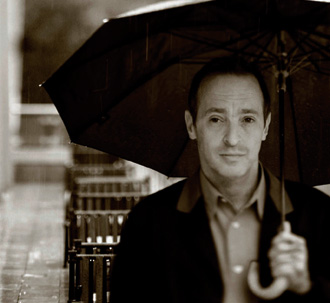
The floor of Finney Chapel vibrated with the stomps and cheers of an eager audience April 10 as satirist David Sedaris stepped up to the stage. His much-anticipated book reading—prefaced by throngs of students lined up hours earlier for the best seats—marked the final segment of Oberlin’s 2006-07 Convocation and Lec-ture Series. All 1,350 free tickets available to students and the public weeks earlier were gone within two hours.
Known for his bitingly witty humor, both in essays and public radio commentary, the engaging Sedaris could do no wrong with the Oberlin crowd. He read two essays that had been published in the New Yorker and GQ: “Old Faithful,” which deals with his own questions of fidelity and comfort in a relationship, and “Town and Country,” which pokes fun at the relationships between social and economic classes in American society.
Speakers at this year’s Convocation Series included author and economist Paul Krugman, an op-ed columnist for the New York Times; Elizabeth Kolbert, political writer for the New Yorker; Andrew Sullivan, TIME essayist and popular blogger; and Ana Marie Cox, an originator of the political blog Wonkette and a columnist for TIME. ATS
Wave Makers
Seth Binder ’07

Major: History
Hometown: Oak Park, Calif.
Club/organization affiliations: Four-year member of the men’s baseball team, Student Athletic Advisory Committee
A warm Miami breeze rushed across the field where Seth Binder stood nervously with 50 other baseball players in late December. This was his chance to play professional ball, albeit not quite the way he had expected. Binder was trying out for the newly formed Israel Baseball League (IBL).
“Coming from a small Division III school, there aren’t many chances to play major league baseball,” he says. “Initially, I was interested in semi-pro or independent leagues. I heard about the IBL from a team member who was hoping to do an internship with them. This will be the league’s first year, and he thought he could help it get off to a good start.”
Binder was selected for try-outs following an outstanding run as an Oberlin shortstop. As a sophomore, he hit .350; a year later he was named to the All-Conference Team after averaging .387.
“Try-outs were nerve-racking at first, but then I calmed down,” he says. “First there was a 60-yard dash, then five ground balls from shortstop. Then we did the batting cage, followed by a simulated game. Afterward they just said, ‘Thank you for coming, we’ll let you know in a few weeks.’”
Binder was offered the contract.
With the league starting in June, Binder will need to sign as soon as his college season is over, a decision he had yet to make before OAM went to press.
How do you feel?
It’s exciting to even be considered for the league’s first year. It’s extra special to be able to play in Israel, where there is so much history.
If you take the offer, what do you hope to gain from the experience?
I hope to keep developing as a baseball player, and to learn what life is like in a tense, political and religious community. The struggles of the Jewish people in-spire me, and the opportunity to play in the land dedicated to them is exciting.
